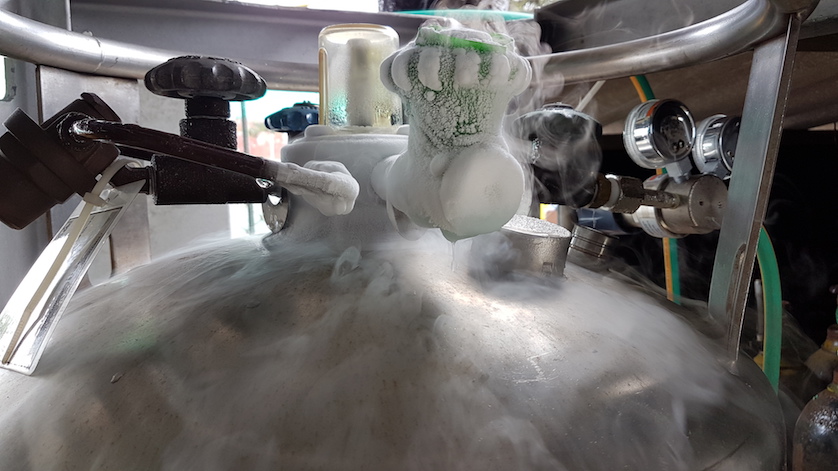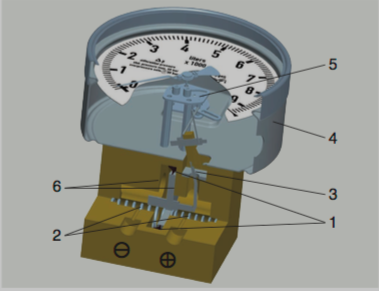
For years, makers of cryogenic equipment have had to fabricate their own differential pressure systems to measure the gas’s liquid level and working pressure. WIKA’s innovative Cryo Gauge is a compact, all-in-one solution that saves manufacturers time, money, and hassle.
A variety of industries, from hospitals and laboratories to production facilities, rely on a steady supply of oxygen, nitrogen, argon, carbon dioxide, nitrous oxide, and other medical and technical gases. And the need is rising. As more people come down with acute cases of COVID-19, healthcare facilities require more oxygen to help patients breathe via medical ventilators. That’s why large gas tanks are found outside every hospital, while smaller facilities – medical clinics, field hospitals, etc. – have microbulk tanks.
Differential Pressure Measurement for Cryogenic Tanks
Differential pressure gauges are ideal for monitoring liquid levels in closed vessels. These systems work by measuring the gaseous (P1) and liquid (P2) pressures of the fluid within a tank, and then calculating the differential pressure (DP). This differential pressure value indicates how much product – liquid gas – is left inside the tank.
For transport and storage, medical and industrial gases have to be liquefied. However, most DP gauges have their limitations when it comes to cryogenic gases. The sensors need to be rugged enough to handle high pressures, yet sensitive enough to indicate a very low differential pressure.
Another issue is that most DP gauges are limited to one pressure range and, thus, can be calibrated to only one particular gas over the full span. Let’s take nitrogen, oxygen, and argon as examples. N2 is lighter than O2, which is lighter than Ar. Assuming all three are in the same size of tank, the same dial that indicates N2 at 100% would show a full tank of O2 at only 70%, and a full tank of Ar at only 57%. This meant manufacturers needed a different DP gauge for each type of gas, or use a gauge with three gas scales, of which only the argon scale would go over the full span.
What’s more, knowing just the level is not enough. Cryogenic gas tanks need a gauge for indicating the working pressure (WP), as well as an equalizing valve to set the point at zero during routine testing. This meant tank equipment manufacturers had to:
- Source DP and WP gauges, valves, fittings, and piping from multiple suppliers, and to store all the parts.
- Spend time assembling their own system with multiple connections, with each connection being a potential leak point.
- Check the entire system for leaks after assembly is complete.
- Clean the assembly for O2 service.
The process was time consuming and labor intensive, and the resulting assembly was often a bulky mass of parts, connectors, and piping.
WIKA’s Liquid Level Gauge for Cryogenic Gas Tanks
Manufacturers of liquefied gases were looking for a compact all-in-one solution. With valuable input from major players in the industry, WIKA came up with an engineered solution: Cryo Gauge models 7X2.15.100 and 7X2.15.160.

Diagram of the Cryo Gauge
The design is simple but innovative. Two media chambers, ⊕and ⊖, detect the gaseous (P1) and liquid (P2) pressures. An elastic diaphragm (1) divides the two chambers. The differential pressure, or P1minus P2, causes the diaphragm to deflect against the measuring range spring (2). This deflection, which is proportional to the DP, acts upon a lever mechanism (3) in the indicating case (4) to transmit the information to the movement (5). Metal bolsters (6) on either side of the diaphragm protect the gauge against overload and pressure spikes.
The measuring cells are made of a copper alloy (models 712.15.100/160) or 316 stainless steel (models 732.15.100/160). The rest of the wetted parts and much of the non-wetted parts are also stainless steel for corrosion resistance. This innovative assembly combines the reliability and value of a mechanical gauge, along with a host of add-on accessories for greater usability, including remote signal transmission.
Part 2 of this article continues with a list of features that make WIKA Cryo Gauges the leader in liquid level measurement for cryogenic gas tanks.


Does your liquid level gauge have an option to provide us with either a linear current signal, like samson does, or an electronic or resistive transducer to help us with a computertized system we are developing?
Thanks,
David
Dear Sir,
We are using WIKA make level gauge ( 0-12500mmwc, 9000ha4q, 110bvvb1) for cryogenic liquid oxygen level measurements. Earlier tank was used at 6 Bg, Now operating at 12 Bg. Will be any difference of liquid level, if so why & what will be calculating formula.
Please support
Hi Gaurab. Thank you for your comment. A product manager should be reaching out to you shortly if they have not already.